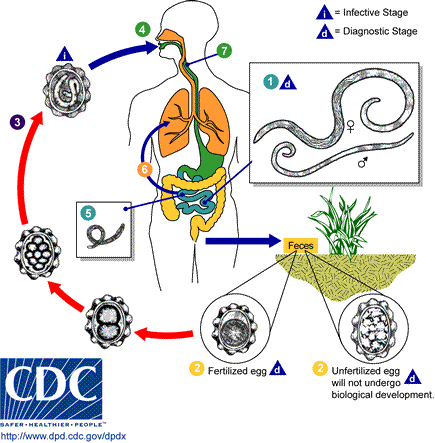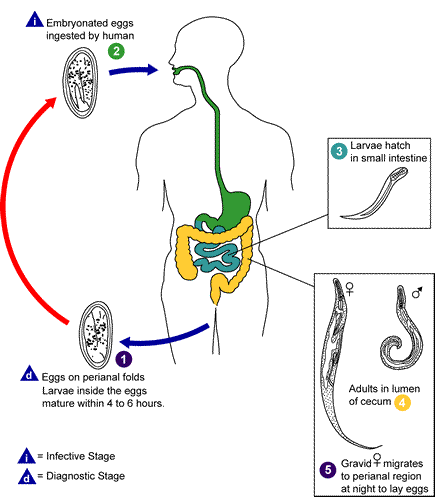Nematodes, or roundworms, are the most diverse phylum of pseudocoelomates and one of the most diverse animal phyla. Nematodes are characterized by the presence of a tubular digestive system with openings at both ends. They can be found in various ecosystems ranging from the polar regions to the tropics, fresh to marine water and various terrestrial environments ranging from mountains, deserts and oceanic floors. Nematodes are also capable of exhibiting parasitic behavior that contribute to digestive system diseases. Analysis of parasitic nematodes reveals the presence of specific body structures which promote parasitic behaviors such as ridges, rings or bristles that allow for attachment. Parasitic nematodes that commonly infect humans include ascarids (Ascaris), pinworms (Enterobius), whipworms (Trichuris trichiura), filarias and hookworms. The following is a brief overview of two of these types of roundworms, including Ascaris and Enterobious.
Ascariasis
Ascariasis is a disease that is caused by the parasitic roundworm Ascaris lumbricoides. Ascariasis is commonly found in tropical and sub-tropical regions and is transmitted by ingesting food contaminated with Ascaris eggs that are typically present in the feces of an infected individual. Upon ingestion of Ascaris eggs, the larvae continue development and hatch within the intestine of the host. The larvae burrow through the intestinal wall and begin circulation in the system and migrate to the lungs. Once they have migrated to the lungs, the larvae break into the alveoli and continue to move through the trachea and esophagus where they are eventually coughed up and swallowed. For a second time, the larvae enter into the intestine and mature into adult worms . Individuals affected with ascariasis can be asymptomatic or suffer from visceral damage due to the travel of the larvae through the body. The presence of the worms within the intestine may also result in malabsorption or intestinal blockage.

Ascariasis Life Cycle
An overview and summary of the life cycle leading to Ascariasis.
Enterobius
Enterobius, referred to as pinworm, is a type of parasitic nematode that is commonly found in the intestine of children. This infection is often called enterobiasis. The entire life cycle of the pinworm occurs within the human gastrointestinal tract. The life cycle begins with ingestion or insertion of eggs in the anus that have been transmitted via human-to-human contact. The life cycle of the Enterobious ends with eggs laid in the anus and transfered to surfaces that come in contact with this region, such as fingernails, hands, night-clothing and bed linens. Infection by pinworm is more prevalent in children due to their behaviors. Upon infection with eggs, they travel to the small intestine and hatch. The pinworm larvae will then migrate towards the colon and undergo molting which allows for further development. After two molt cycles, the larvae have developed into adults. The pinworms exhibit the ability to mate in the small intestine. Shortly after mating, the male worms die and are passed out via the feces. However, the female pinworms will attach to the mucus and wait for the egg-laying process to begin. The egg-laying process begins with the migration of the females towards the rectum. The eggs, which are covered with a sticky covering, are then released and deposited on the outside or near the anus. The cycle begins again once eggs are ingested and infect an additional host .

Overview of the pinworm life cycle
Overview of the pinworm life cycle, specifically Enterobius vermicularis.